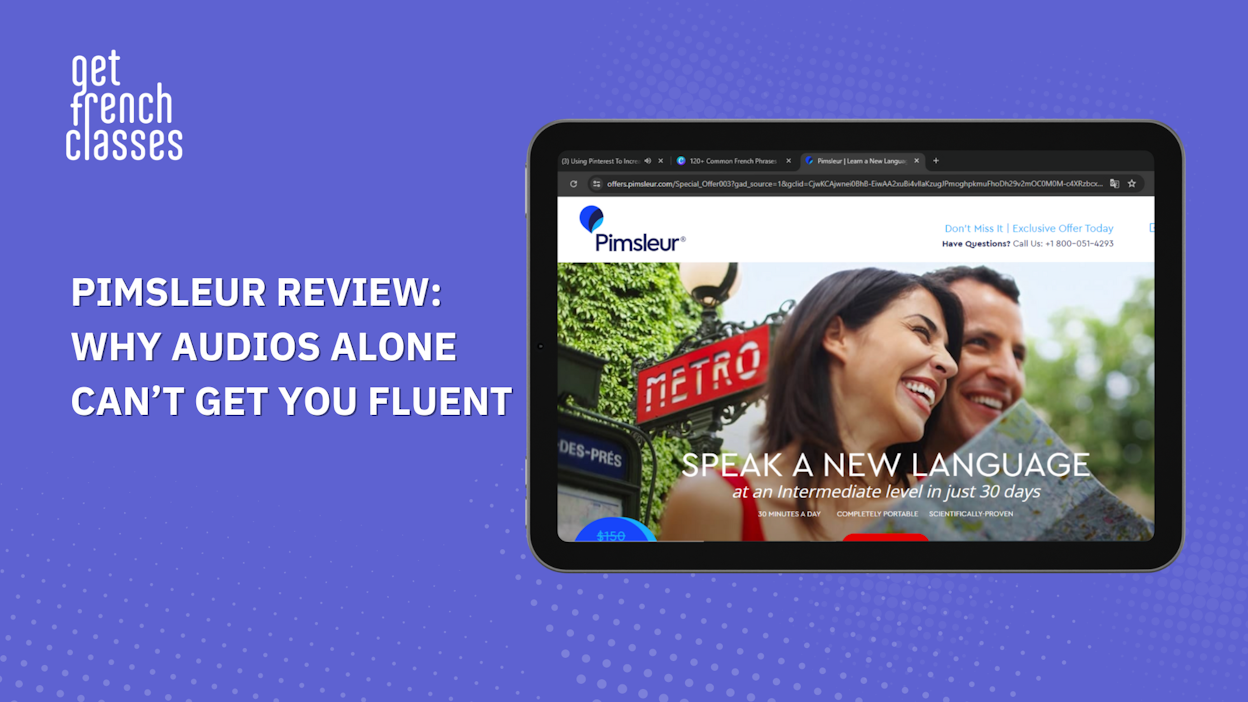Just like you today, 8 years ago, I found myself in your position, wondering whether Pimsleur was the right language tool for me. I eventually ended up not using Pimsleur for various reasons. In this Pimsleur review, I'm sharing my experience with the Pimsleur program.
What is Pimsleur, and what's the Pimsleur Method™?
Pimsleur is a language learning program developed by Dr. Paul Pimsleur, an applied linguist who dedicated his career to understanding how people acquire languages.

Back in the 1960s, Dr. Pimsleur wasn't satisfied with how adults were learning languages, so he researched to figure out a better way. What he came up with is pretty fascinating.
Basically, Dr. Pimsleur figured out that there's an ideal schedule for reviewing what you've learned so that it naturally sticks in your mind. You know how sometimes you cram for a test and forget everything the next day?
Well, this method is the opposite of that. It's designed to move information into your long-term memory.
Here's where Pimsleur really stands out: It's almost entirely audio-based. When you think about it, that's how you learned your first language as a kid, right? You didn't start with grammar books; you listened and spoke.
Pimsleur taps into that natural learning process.
When you're doing a Pimsleur lesson, you'll hear new words and phrases, and then you'll be asked to recall and use them at specific intervals. This active recall is actually rewiring your brain to use the language more naturally.
This method is called spaced repetition. And since then, it's been the backbone of the Pimsleur Method™.
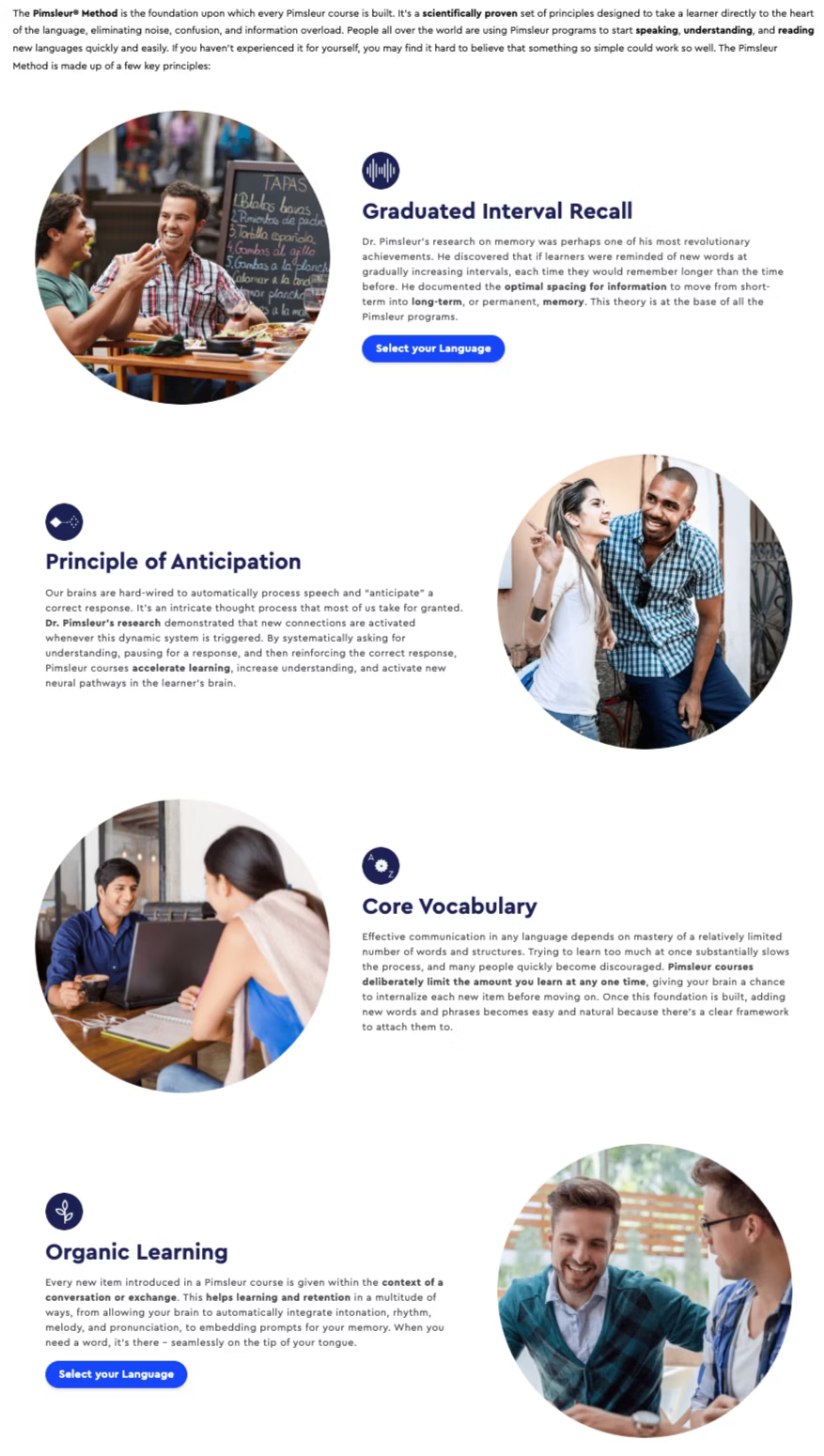
How much does Pimsleur cost and is it worth it?
When it comes to pricing, Pimsleur offers several options, but they're not exactly budget-friendly. Let's break it down:
Subscription model:
-
$14.95 per month for audio content in one language
-
$20.99 per month for audio content plus interactive exercises in all languages
Outright purchase:
-
$119.95 for a single level of MP3 files (about 30 lessons)
-
Full course in one language (typically 5 levels) costs nearly $600
At first glance, the subscription model might seem reasonable. However, when you consider that Pimsleur is primarily an audio-based pimsleur program, the value proposition becomes questionable.
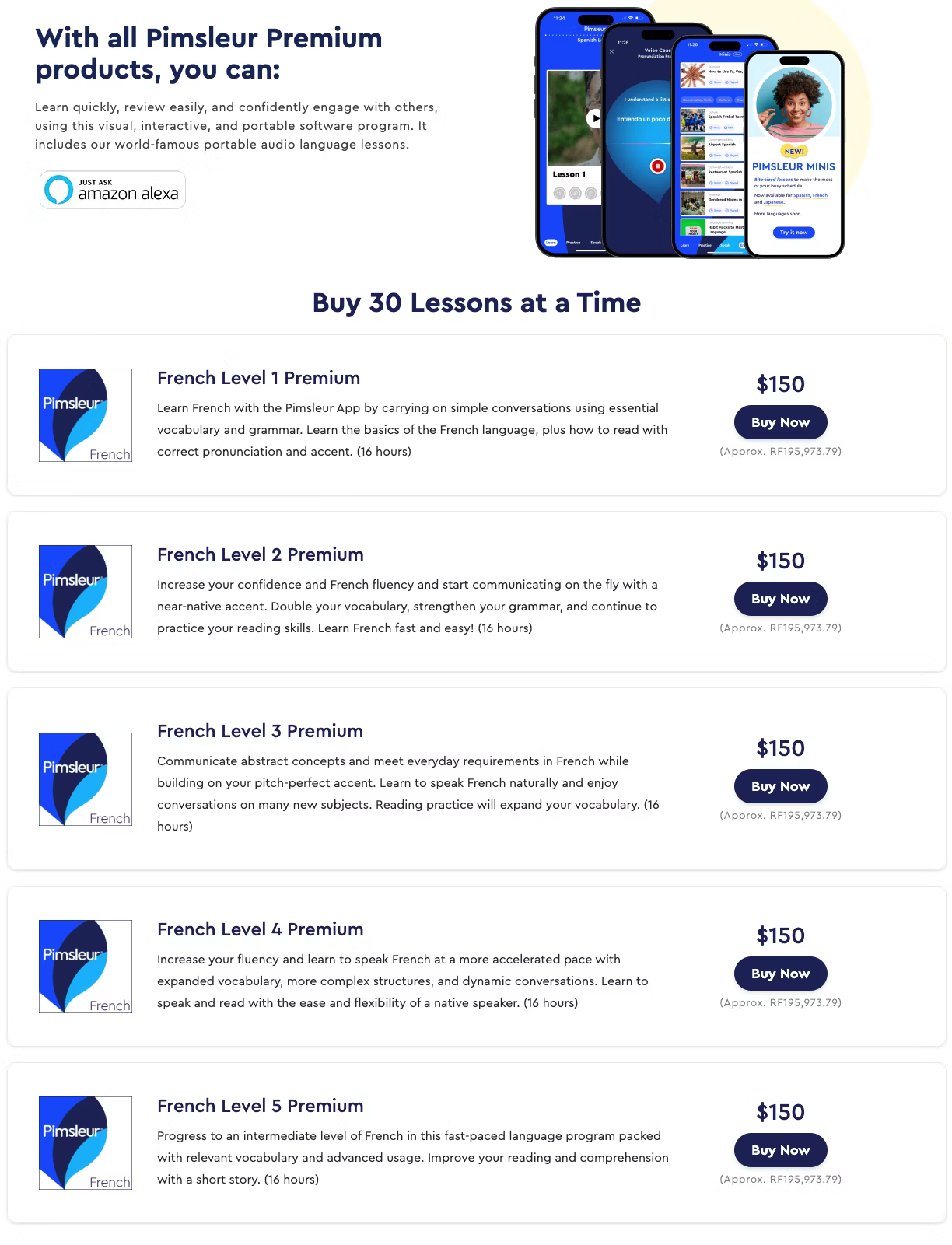
For $600, you could:
-
Take 12-15 private language lessons with a native speaker
-
Purchase a round-trip ticket to a country where your target language is spoken
-
Buy several comprehensive textbooks and a few months of a more affordable language app subscription
The high price point becomes even more difficult to justify when you consider what you're getting—or rather, what you're not getting. Pimsleur doesn't offer:
-
Visual learning materials
-
Interactive exercises (unless you opt for the pricier subscription)
-
Writing practice
-
Cultural context
While audio learning has its place, especially for commuters or those who prefer auditory learning, the cost of Pimsleur seems prohibitive for what it offers.
It's essentially asking you to invest a significant amount in a single learning method, which goes against the principle of diversifying your language learning approach.
In my experience, Pimsleur can be a useful tool, but it's not comprehensive enough to justify its high price tag. It's most effective when used in conjunction with other resources, but at this price point, it leaves little room in your budget for those additional materials.
If you're considering Pimsleur, I'd recommend trying their free lesson first to see if the method resonates with you.
If it does, consider the monthly subscription rather than buying outright, and be prepared to supplement it with other resources for a well-rounded language learning experience.
My Experience with Pimsleur and why I couldn't keep up with it
My first encounter with Pimsleur was back in 2016, when I was embarking on learning my first second language. Unfortunately, it didn't take long for me to realize that Pimsleur wasn't the right fit for my learning style.
The program's structure couldn't keep me engaged or motivated; I found it mostly boring, and the audio-only format was a significant hurdle. As a visual learner (like most people), I struggled to connect with the content.
At that time, I gravitated toward Rosetta Stone and Duolingo. Rosetta Stone's visual approach and Duolingo's gamified system seemed more appealing and engaging.
However, as I've mentioned in previous posts, I eventually discovered the limitations of these platforms too, and ended up investing in live classes.
Interestingly, I did circle back to Pimsleur later in my language-learning journey. By this point, I could already speak the language but wanted to refine my pronunciation and accent.
Surprisingly, Pimsleur clicked for me this time around. The key difference was that I wasn't relying on it to learn or grow my fluency, but rather to fine-tune my pronunciation.
This experience led me to conclude that Pimsleur's strongest use case isn't for comprehensive language learning, but for improving dictation and pronunciation.
It's a tool best suited for learners who already have a foundation in the language and are looking to polish their speaking skills.
Pimsleur pros: What I like about Pimsleur
Despite my initial struggles with Pimsleur, it would be unfair to dismiss it entirely. The program does have its merits, and in certain contexts, it is a valuable tool in a language learner's arsenal.
While my overall experience might sound somewhat negative, there are aspects of Pimsleur that deserve recognition.
Effective for pronunciation and listening skills
Pimsleur truly shines when it comes to improving pronunciation and listening skills. The program's audio-based approach, which initially felt like a drawback, turns out to be its strength in this area.
Through repetitive listening and speaking exercises, Pimsleur helps attune your ears to the nuances of the target language and trains your mouth to produce more native-like sounds.
In my personal experience, I found this aspect particularly beneficial when I returned to Pimsleur with an existing language foundation. The program's emphasis on mimicking native speakers helped me refine my accent and improve my overall pronunciation.
For instance, when I was learning Spanish, Pimsleur helped me master the notoriously difficult nasal sounds that don't exist in English.
It's worth noting that, for complete beginners, this intense focus on pronunciation might feel overwhelming. Without context or visual cues, it can be challenging to grasp and reproduce unfamiliar sounds.
However, for learners who already have some basic language skills, Pimsleur can be an excellent tool for improving listening comprehension and accent through shadowing techniques.
The program's method of gradually introducing and reinforcing sounds and phrases allows learners to internalize the rhythm and intonation of the language.
This can lead to more natural-sounding speech and an improved ability to understand native speakers, which are crucial skills often overlooked in more grammar-focused or text-based learning methods.
Structured approach with clear expectations
One of Pimsleur's strengths lies in its well-structured approach to language learning. The program offers a clear, step-by-step path that eliminates the guesswork often associated with self-study methods.
Each lesson is designed to be completed in about 30 minutes, making it easy to integrate into daily routines.
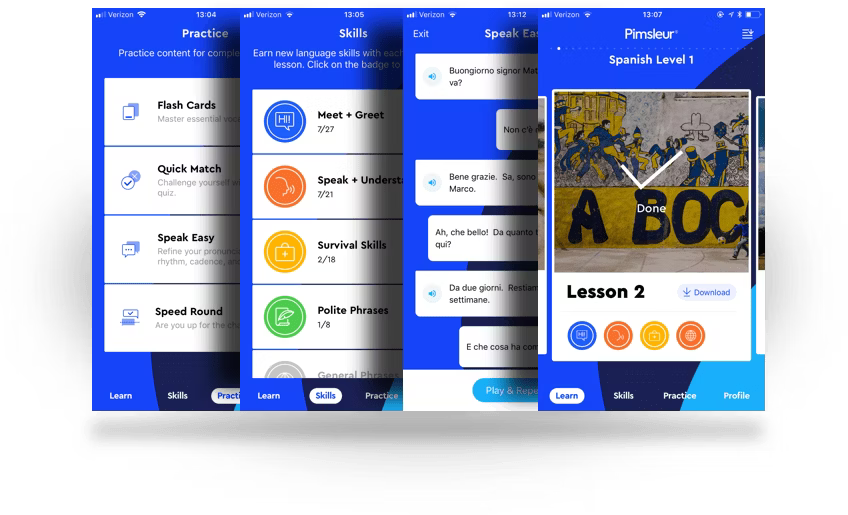
The course structure is straightforward: you're expected to complete one lesson per day, in sequential order.
This clarity helps set realistic expectations and provides a sense of progress. You know exactly what you need to do each day and how long it will take, which can be motivating for learners who thrive on routine and measurable advancement.
I found this structure particularly helpful when I returned to Pimsleur to refine my pronunciation. The predictable format allowed me to focus on the content without worrying about navigating complex interfaces or deciding what to study next.
This structured approach can be especially beneficial for busy adults who need a language learning method that fits into their schedule without requiring extensive planning or preparation.
Convenience of audio-based learning
Admittedly, the audio-only format initially posed a challenge for me as a visual learner, but I came to appreciate its convenience. Pimsleur's audio lessons offer unparalleled flexibility in terms of when and where you can study.
The ability to learn while commuting, exercising, or doing household chores is a significant advantage.
During my second stint with Pimsleur, I often listened to lessons while driving or cooking, effectively turning otherwise idle time into productive language practice.
This hands-free, eyes-free learning method allows for seamless integration into your daily life, making it easier to maintain consistency in language study.
Moreover, the audio format encourages active listening and speaking, skills that are important for real-world language use but often underdeveloped in text-based learning methods.
By forcing you to rely solely on what you hear, Pimsleur helps train your ear to pick up on subtle nuances in pronunciation and intonation.
However, it's important to note that this convenience comes with trade-offs. The lack of visual aids can make it challenging to grasp certain concepts, especially for visual learners or when dealing with languages that use unfamiliar scripts.
Also, the audio-only format doesn't provide opportunities for reading or writing practice, which are essential components of comprehensive language learning.
Emphasis on practical conversation skills
One of Pimsleur's strongest suits is its focus on practical, conversational language.
Unlike many traditional language learning methods that start with grammar rules or isolated core vocabulary, Pimsleur is more focused on real-world dialogue scenarios. This approach aligns well with the needs of learners, who primarily want to communicate effectively in everyday situations.
For my experience, I found that the phrases and expressions taught in Pimsleur were immediately applicable in real-life contexts.
For instance, when I used Pimsleur to brush up on my Spanish, I noticed that the language program prioritized common conversational patterns like asking for directions, ordering in restaurants, or engaging in small talk. These are precisely the types of interactions most travelers or beginner language learners need to master first.
Also, by encouraging learners to produce full sentences rather than just single words, Pimsleur helps overcome the common hurdle of "language freeze" that many experience when trying to speak a new language.
I noticed this benefit, particularly when I returned to Pimsleur to improve my pronunciation—the familiar phrases gave me a comfortable base from which to work on my accent and intonation.
However, it's worth noting that while Pimsleur excels at teaching practical conversation skills, it may not provide the depth needed for more advanced language use or specialized contexts. The vocabulary and situations covered, while useful, are somewhat limited.
For learners aiming for professional fluency or academic language skills, Pimsleur should be complemented with other resources.
Pimsleur cons: What I dislike about Pimsleur?
While Pimsleur has its strengths, it's far from a perfect language-learning solution.
My experience with the pimsleur program revealed several significant drawbacks that potential users should be aware of. These limitations can hinder overall language acquisition and may make Pimsleur unsuitable as a standalone learning method for many learners.
Let's delve into some of the main issues I encountered.
Limited vocabulary acquisition
One of the most glaring weaknesses of Pimsleur is its limited vocabulary range. The program introduces new words at a slow pace, focusing more on repetition and recall of a core set of phrases than expanding your lexicon.
In my experience, after completing several levels of Pimsleur, I found my vocabulary to be quite restricted (basic vocabulary) compared to what I could achieve with other methods in the same time frame.
For instance, when I was using Pimsleur for Spanish, I noticed that even after numerous lessons, I was still working with a relatively small set of words. This became frustrating when I tried to express more complex ideas or discuss topics beyond basic conversations.
The program's focus on high-frequency words and phrases is useful for getting started, but it quickly becomes a limitation for learners aiming for more comprehensive language skills.
This narrow vocabulary range can leave learners ill-equipped to handle diverse real-life situations or to understand authentic materials like news articles, books, or movies in their target language.
Lack of reading and writing practice
Another major shortcoming of Pimsleur is its near-complete neglect of reading and writing skills.
As an audio-based program, Pimsleur naturally focuses on listening and speaking, but this comes at the expense of developing literacy in the target language.
During my time with Pimsleur, I found myself increasingly proficient in understanding spoken language and producing basic sentences, but I was at a loss when it came to reading even simple texts or writing basic messages.
This imbalance became particularly problematic when I tried to use my language skills in real-world situations that required reading (like understanding menus or street signs) or writing (like sending emails or text messages).
For languages with non-Latin alphabets or character-based writing systems, this lack of reading and writing practice is even more problematic.
When I briefly tried Pimsleur for Mandarin Chinese, I realized that while I could say a few phrases, I had no idea how to recognize or write Chinese characters. This severely limited my ability to engage with the language in any meaningful way beyond basic spoken interactions.
Formal language focus
Pimsleur's approach to language instruction leans heavily towards formal speech, which can be both a blessing and a curse.
While it's beneficial to learn polite forms of address, especially for business or formal social situations, the program often overlooks colloquial expressions and informal speech patterns that are super important for everyday conversations.
For instance, a friend who's used Pimsleur's Spanish course found himself sounding overly formal in casual settings. He was using “vous” (the formal “you”) in situations where native speakers would naturally use “tu” (the informal “you”).
This formality gap became apparent when he tried to converse with French peers, and his speech sounded stilted and unnatural.
It's a significant limitation for those aiming to integrate into the culture or converse naturally with locals.
Repetitive nature of lessons
While repetition is a key aspect of language learning, Pimsleur takes this to an extreme that can become tedious and demotivating.
The lessons follow a very predictable pattern, with the same phrases and sentence structures repeated multiple times within a lesson and across several lessons.
Initially, this repetition helped reinforce new vocabulary and structures. However, as I progressed through the course, I found myself growing increasingly bored with the monotonous format.
The lack of variety in exercise types and the constant recycling of the same content made it challenging to stay engaged and motivated.
This repetitive nature can be particularly frustrating for learners who progress quickly or those who have some prior knowledge of the language.
It doesn't allow for much flexibility in terms of learning pace or content customization, which can lead to a sense of stagnation in one's language learning journey.
High price point compared to alternatives
One of the most significant drawbacks of Pimsleur is its cost, especially when compared to other language learning resources available in the market. The full Pimsleur course for a single language can run into hundreds of dollars, which is a substantial investment for many learners.
The price of Pimsleur surprised me when I first considered it. For the cost of a complete Pimsleur course, I could have:
-
Purchased several comprehensive textbooks and workbooks
-
Subscribed to multiple language learning apps for an entire year
-
Taken several group classes or a few private lessons with a native speaker
The high price becomes even harder to justify when you consider the limitations of the program—its audio-only format, limited vocabulary, and lack of reading and writing practice.
While Pimsleur does offer a more affordable subscription model, it's still pricier than many alternatives that offer more comprehensive language coverage.
Should you really rely on Pimsleur to get fluent?
After extensively using Pimsleur and analyzing its strengths and weaknesses, I've come to a clear conclusion: Pimsleur's true strength lies in its ability to improve pronunciation and listening comprehension.
It's particularly effective for honing your accent and developing a more natural-sounding speech pattern.
However, audio alone is not sufficient to develop the well-rounded skills necessary for true fluency.
In my experience, Pimsleur works best when used in conjunction with other learning methods. For instance, while I was taking structured language classes and using various apps for vocabulary acquisition, I found Pimsleur to be an excellent supplement for refining my spoken language skills. It helped me sound more like a native speaker, which boosted my confidence in real-world conversations.
However, relying solely on Pimsleur would leave significant gaps in your language skills. It doesn't adequately address reading and writing, limits vocabulary acquisition, and doesn't provide enough context for understanding the cultural nuances of language use. These are key components of true fluency that Pimsleur simply can't deliver on its own.
Moreover, language learning is a multifaceted process that requires engagement with various types of input and practice. While Pimsleur's audio-based approach is valuable, it doesn't cater to different learning styles or provide the variety of exercises needed for comprehensive language acquisition.
To truly become fluent, you need a more holistic approach. This might include:
-
Structured lessons (either through classes or comprehensive online courses) for grammar and vocabulary
-
Reading practice with authentic materials
-
Writing exercises to develop literacy skills
-
Conversation practice with native speakers
-
Immersion in the language through movies, podcasts, and other media
In this broader language-learning ecosystem, Pimsleur can play a valuable role. Use it to perfect your pronunciation, improve your listening skills, and gain confidence in speaking. But remember, it's a complementary tool, not a complete solution.
Get French Classes: A better Pimsleur alternative if you’re learning French
While Pimsleur is a great tool, it still falls short in many areas critical for effective language learning. And if you're specifically looking to learn French, Get French Classes is a way better alternative.
As someone who has experienced the frustrations of language learning apps firsthand, I can confidently say that Get French Classes addresses many of the shortcomings of platforms like Pimsleur, Rosetta Stone, and Duolingo .

Here's why I believe it's a game-changer for French learners:
Structured, immersive learning path
Get French Classes goes beyond a simple curriculum—it offers a meticulously crafted journey through the French language.
Each course is designed with a specific real-life situation in mind, such as navigating a bakery, office, or social event. This approach ensures that what you're learning is immediately applicable to your daily life.
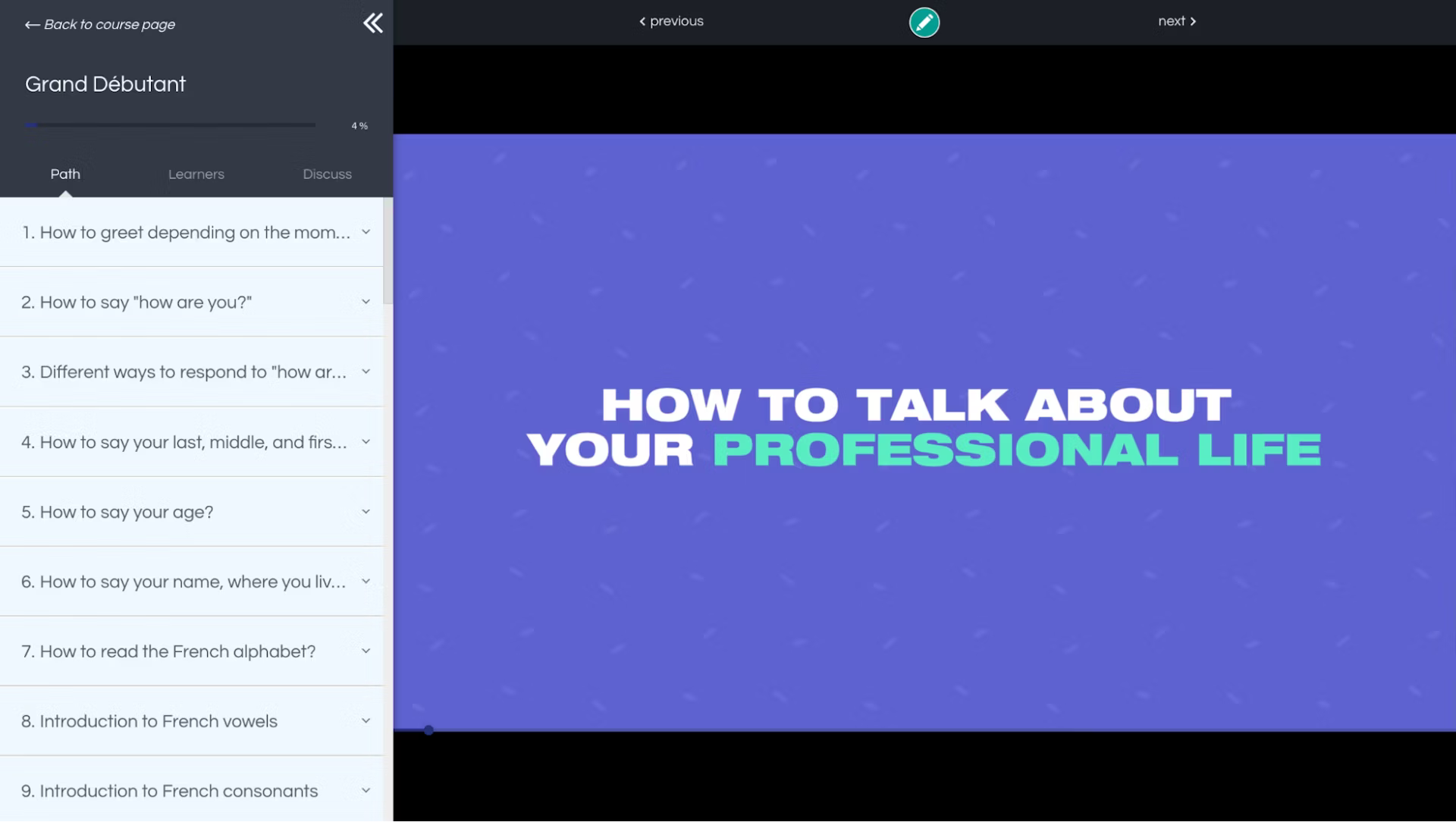
The structure is carefully planned to build upon previous lessons, creating a logical progression from beginner to advanced levels. But it's not just about vocabulary and grammar.
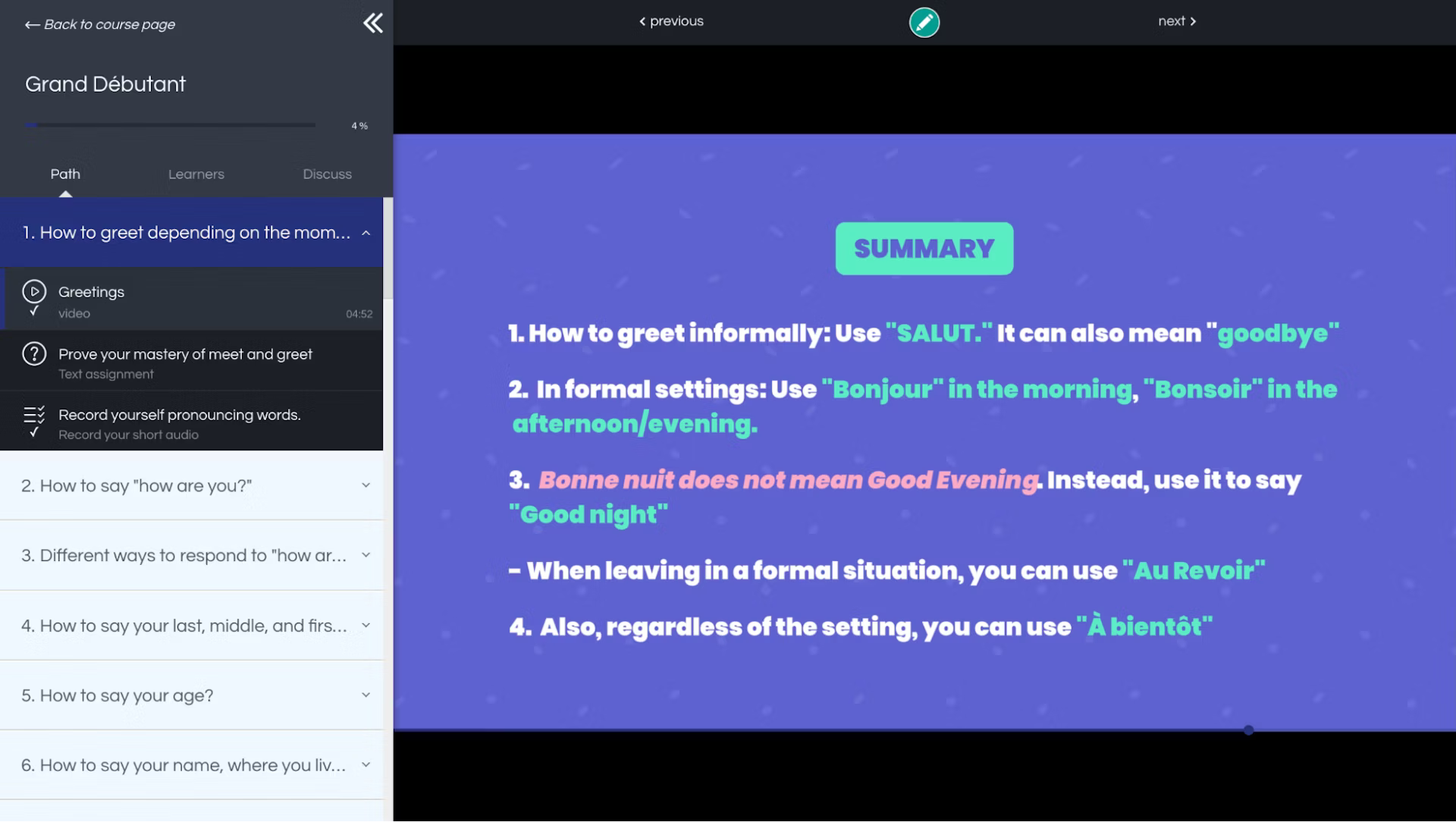
Each lesson is infused with cultural insights, local customs, and even regional variations in French. For instance, a lesson about ordering in a café might include:
-
The etiquette of French dining
-
Common local expressions you'll hear in a café
-
Differences between ordering in Paris versus Marseille
-
The cultural significance of café life in France
This immersive approach helps you not just speak French, but think in French, understanding the cultural context behind the words you're using.
Balance of self-study and live interaction
At Get French Classes, we believe that the best learning experience happens when you blend self-paced learning with invaluable live interaction.
So, we designed our program around that philosophy.
Here's how:
Self-study components:
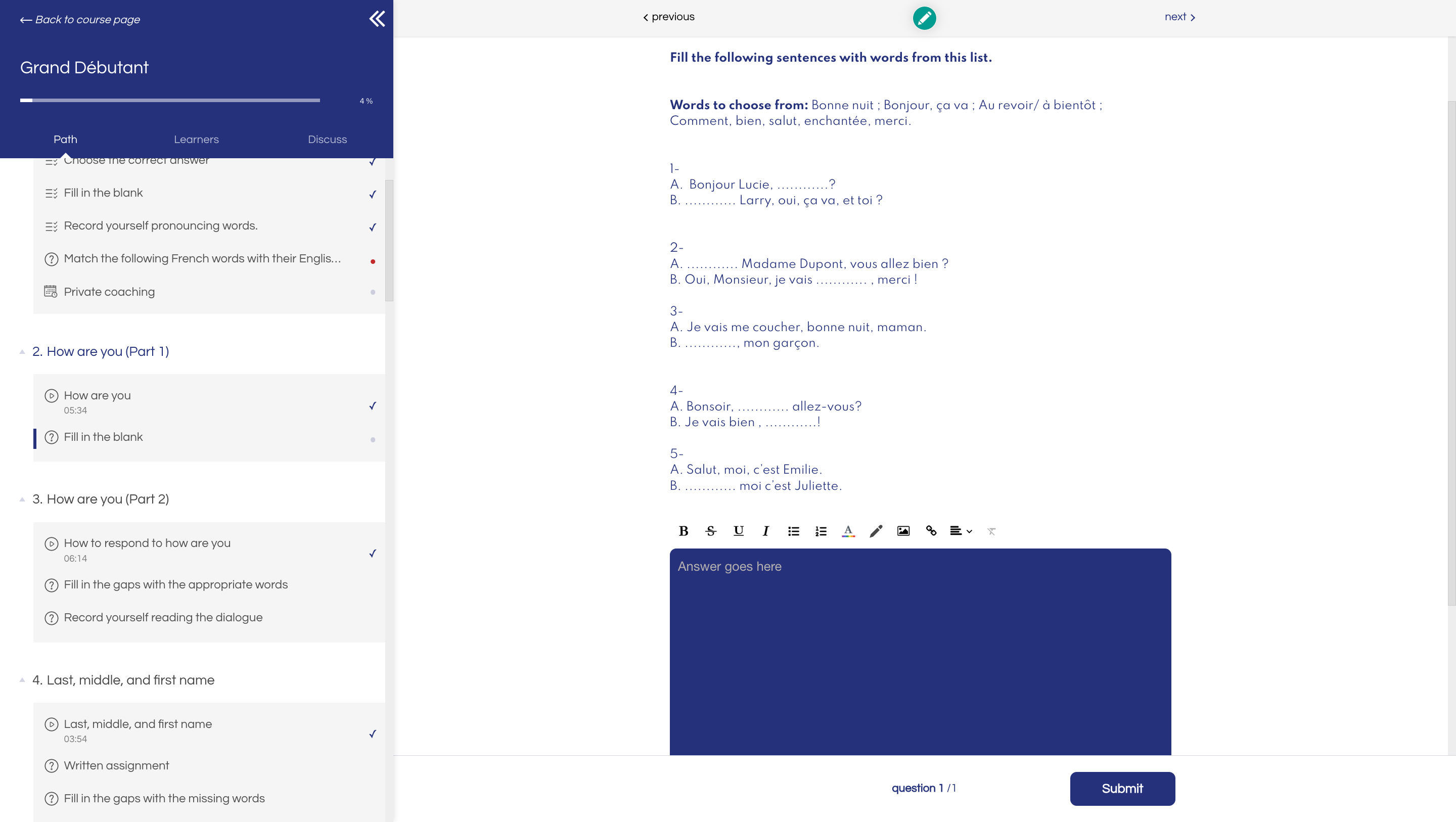
-
50+ interactive video lessons that allow you to practice pronunciation and receive instant feedback
-
100+ carefully designed assignments that apply what you've learned to real-world scenarios
-
A vast library of supplementary materials including audio content, cultural notes, and grammar explanations
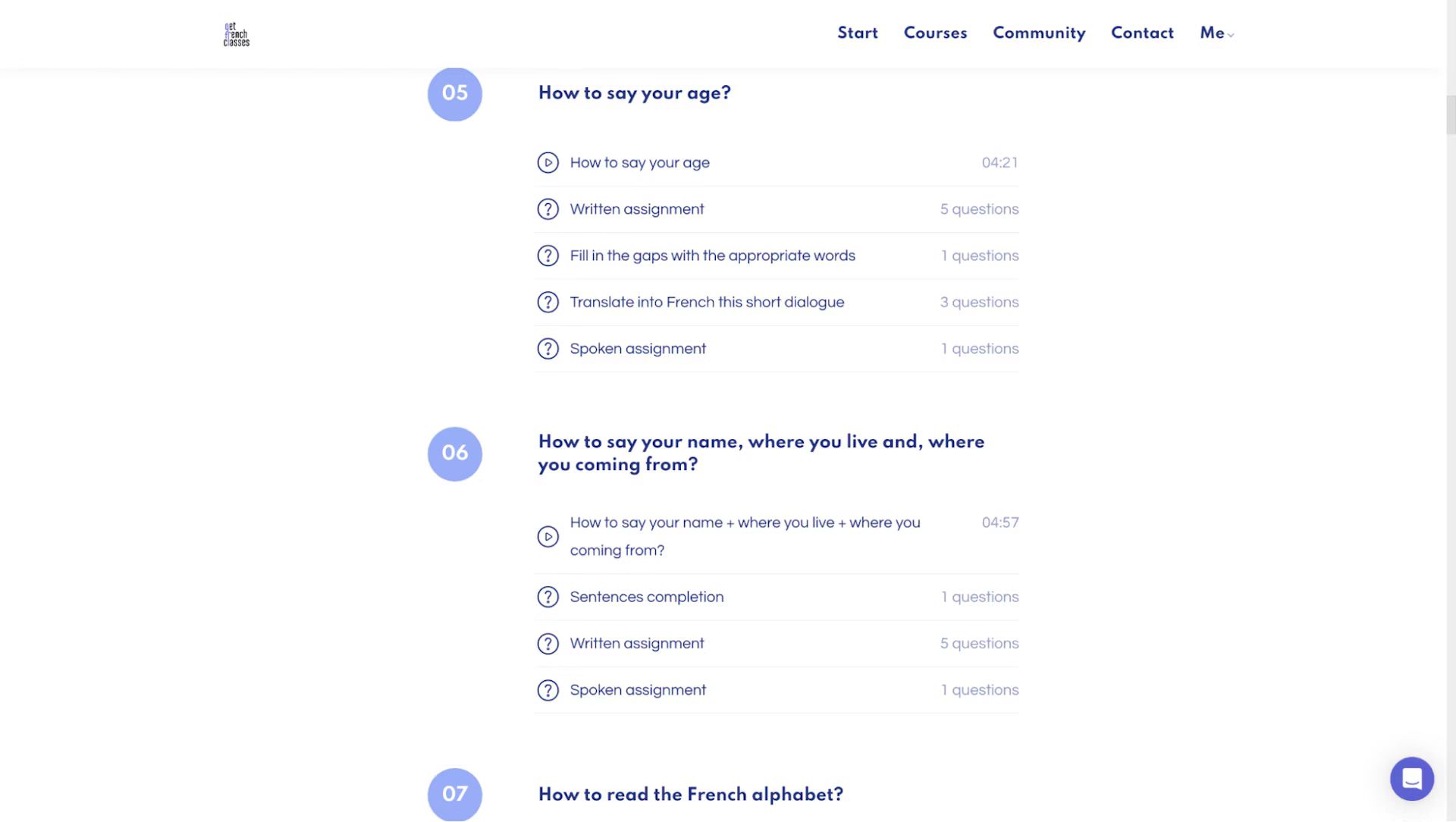
Live interaction:
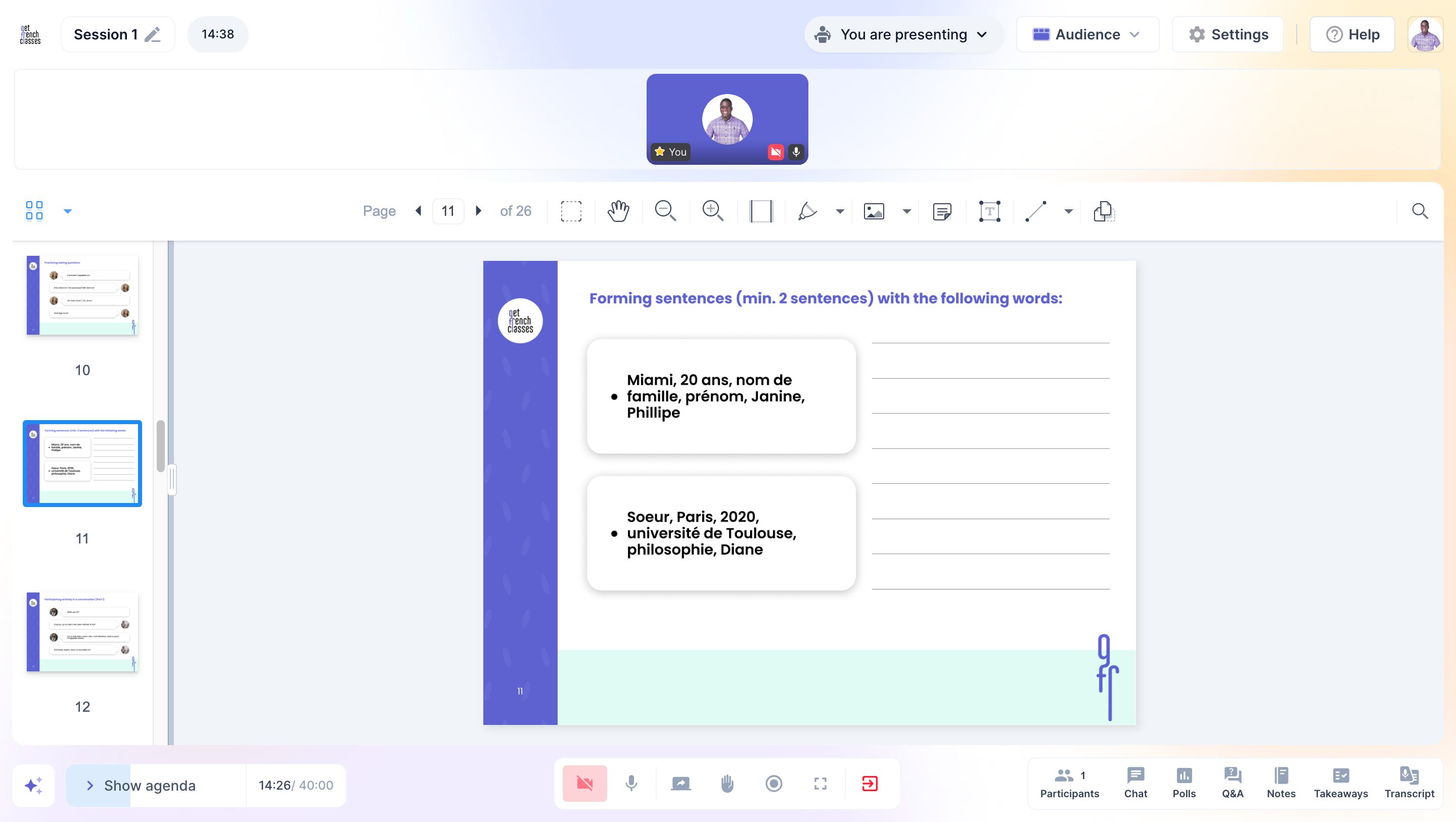
-
6 hours of private classes tailored to your specific needs and learning style
-
6 hours of group classes offering opportunities for dynamic conversation practice, debates, and role-playing exercises
-
Live sessions with native French tutors who can explain nuances, answer questions, and provide immediate feedback
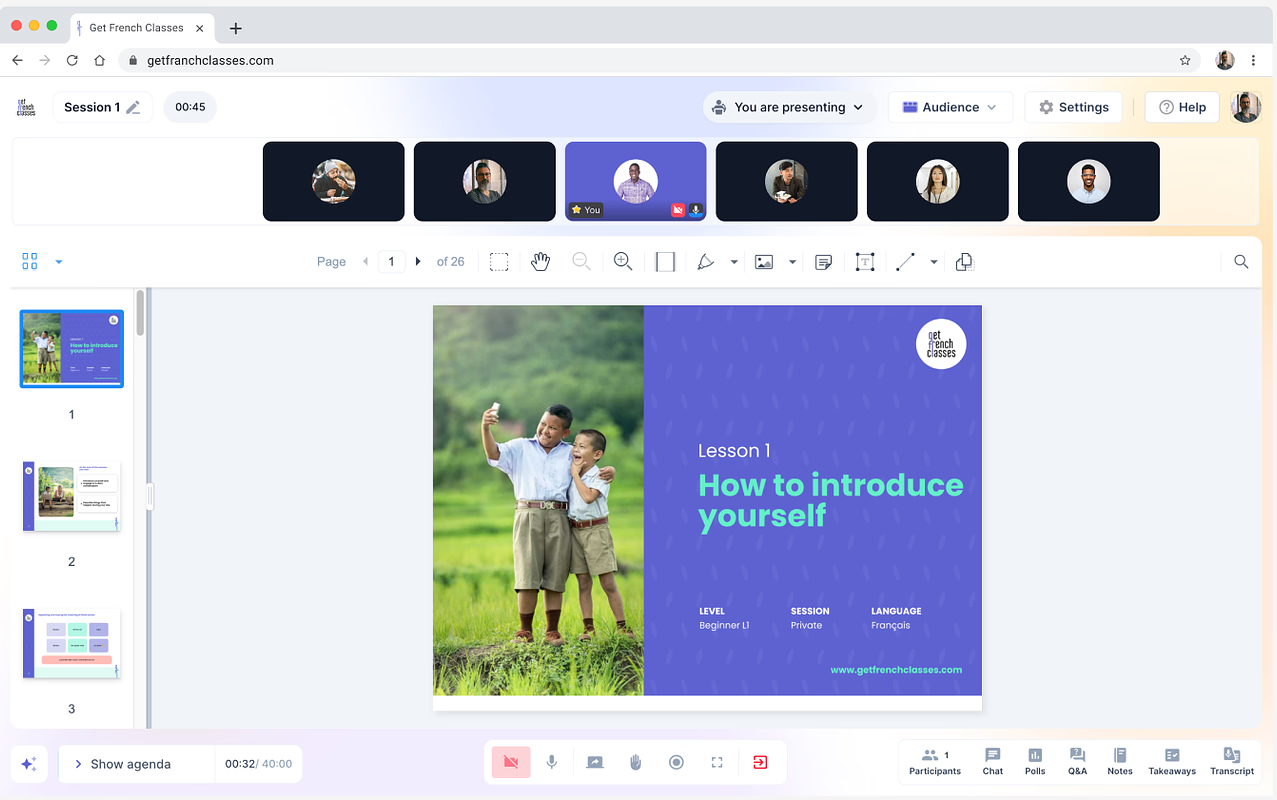
This balanced approach ensures that you're not just memorizing phrases, but truly understanding and internalizing the language. The self-study components allow you to learn at your own pace, while the live interactions provide the practice and feedback needed to truly master French.
Here are some of our tutors:
Community and accountability
We also created a robust system to keep you motivated and engaged throughout your learning journey:
Learning pods
You're placed in a carefully curated group of six students at similar levels, guided by a dedicated tutor.
These pods engage in:
-
Weekly discussions on various topics
-
Cultural exchange activities
-
Virtual "field trips" to French-speaking regions via video tours
-
Collaborative projects that require using French in practical ways
Accountability partners
You're paired with another learner to:
-
Check-in on each other's progress regularly
-
Practice speaking French together outside of class time
-
Motivate each other to stick to learning goals
Community forum
A broader platform where all learners can:
-
Share resources and learning tips
-
Organize language exchange meetups
-
Plan trips to French-speaking countries
-
Discuss French culture, movies, books, and current events
Progress tracking
The platform provides detailed analytics on your learning progress, including:
-
Time spent on different activities
-
Improvement in various skill areas (speaking, listening, reading, writing)
-
Achievement of specific learning milestones
Affordability without compromise
Get French Classes' pricing is for all budgets. At $307 for a comprehensive course, we offer exceptional bang for your buck.
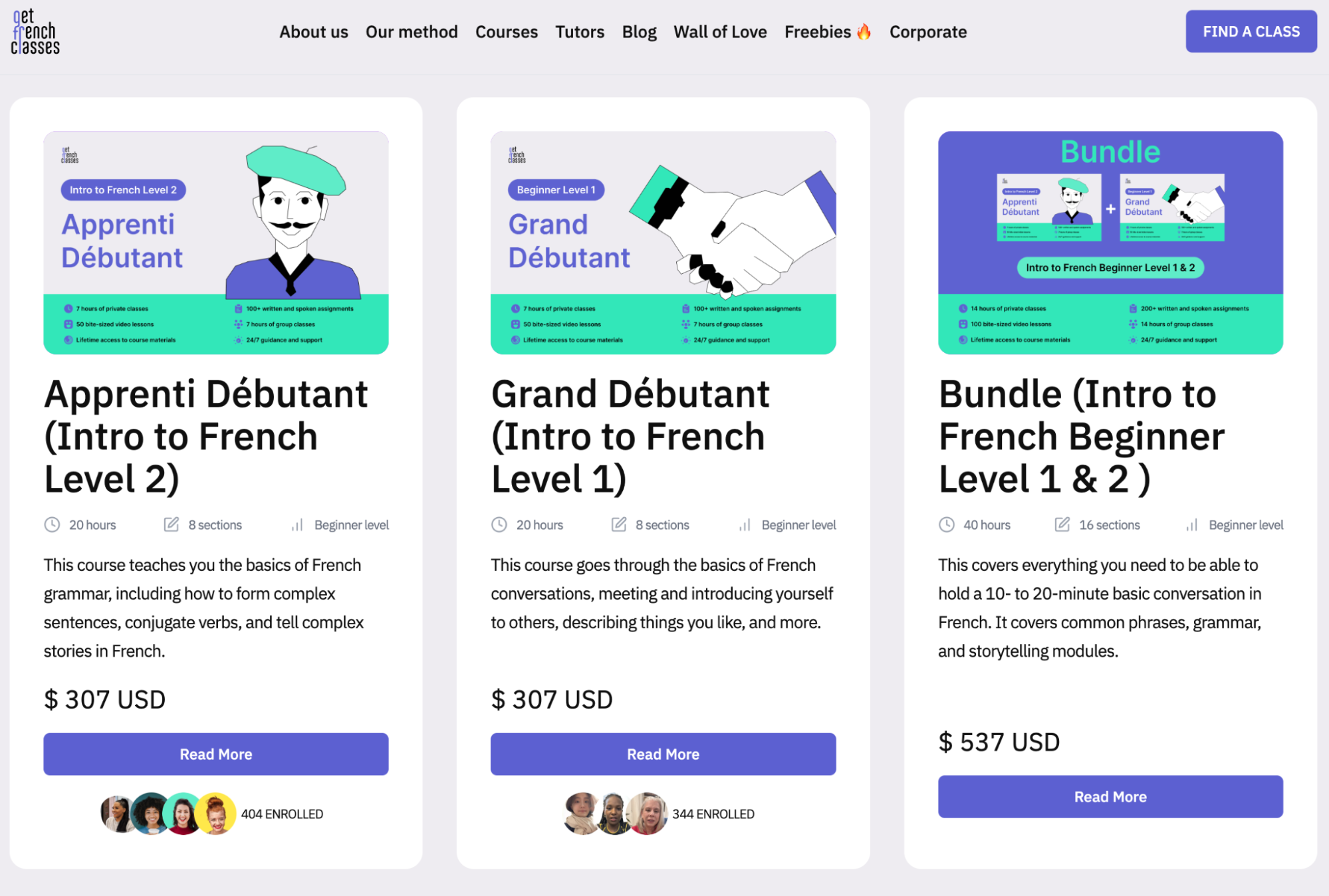
Here's what makes it stand out:
-
Lifetime access: Unlike many platforms that limit access, you get lifetime access to course materials. This allows you to revisit and review even after you've completed the program.
-
All-Inclusive pricing: There are no hidden fees or upsells. The price includes all video lessons, assignments, private tutoring, group classes, and community access.
-
Job board access: Get French Classes provides access to a job board featuring French-speaking positions, adding tangible career value to your learning.
-
Recognized certificates: After passing our DELF DALF exam, you will receive certificates that many employers and educational institutions will recognize, giving your language abilities more professional credibility.
-
Free updates: As the course content is updated and improved, you get access to these updates at no extra cost.
When compared to private tutoring (which can cost $50-$100 per hour) or immersion trips (easily running into thousands of dollars), Get French Classes offers a cost-effective path to fluency without sacrificing quality or comprehensiveness. Here's what some of our learners say:

As a busy mom and professional, learning French has been complicated for me. But since I started learning with Get French Classes, I have seen my French improve FAST. Through the lessons, I not only get to practice every day, but I also have more opportunities than before. I can practice with my advisor, private tutor, and other learners like me.

What I like the most about the program is that all my tutors are native speakers. They do help me not only understand the French language, but also the culture and the nuances of some words and expressions. And mostly, the live sessions are engaging and fun.

I chose Get French Classes because their teaching materials and content are incredibly rich, going from everyday expressions to more specialized ones. I also get many opportunities to interact with tutors, and that has a huge impact on my fluency.
I've tried learning French on my own before, but nothing compares to this program. The combination of video lessons, live tutoring sessions, and group practice made learning French enjoyable and effective.
Flexible schedule
The way we designed our program makes it suitable for everyone, even people with tight schedules.
Here’s how.
-
Bite-sized lessons: Core lessons are broken down into 5-10 minute segments, making it easy to fit learning into even the busiest schedule.
-
24/7 access: All course materials are available round the clock, allowing you to learn whenever it suits you best.
-
Flexible live sessions: Private and group tutoring sessions can be scheduled at your convenience, with options available across different time zones.
-
Microlearning opportunities: Daily challenges and quick exercises that can be completed in just a few minutes, perfect for squeezing in practice during short breaks.
This level of flexibility ensures that your French learning fits seamlessly into your life, no matter how busy or unpredictable your schedule may be.
Pimsleur review: My verdict
Pimsleur can be a great tool for intermediates seeking to fine-tune their accent and pronunciation. Use it as a supplement to other learning methods, particularly for training your listening skills and familiarizing yourself with how native speakers speak.
However, for those aiming for fluency or beginner and advanced proficiency, it falls short.
If you're learning French, are on a budget, and want to hit your fluency goals faster, Get French Classes is the ideal choice. Every one of our courses includes:
-
6 hours of private classes : This allows for personalized attention and feedback, helping you address your specific challenges and accelerate your progress.
-
6 hours of group classes : These sessions provide opportunities for real-world conversation practice, improving your fluency and confidence in speaking French.
-
50 video lessons : This helps you practice daily, reinforcing what you've learned and introducing new concepts in a structured, easy-to-follow format.
-
100+ assignments (writing and speaking) : These exercises ensure you're actively using the language, not just passively absorbing it. They help cement your learning and improve your ability to express yourself in French.
-
A community of learners : This provides motivation, accountability, and opportunities for language exchange outside of formal lessons.
With Get French Classes, you're not just memorizing words and phrases to speak the language quickly; you're immersing yourself in the language and culture, gaining practical skills that you can use in real-life situations.
Our comprehensive approach addresses all aspects of language learning—speaking, listening, reading, and writing - in a way that Rosetta Stone simply can't match.
Here's what our learners say:

As a busy mom and professional, learning French has been complicated for me. But since I started learning with Get French Classes, I have seen my French improve FAST. Through the lessons, I not only get to practice every day, but I also have more opportunities than before. I can practice with my advisor, private tutor, and other learners like me.

What I like the most about the program is that all my tutors are native speakers. They do help me not only understand the French language, but also the culture and the nuances of some words and expressions. And mostly, the live sessions are engaging and fun.

I chose Get French Classes because their teaching materials and content are incredibly rich, going from everyday expressions to more specialized ones. I also get many opportunities to interact with tutors, and that has a huge impact on my fluency.
I've tried learning French on my own before, but nothing compares to this program. The combination of video lessons, live tutoring sessions, and group practice made learning French enjoyable and effective.
